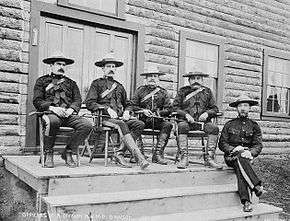Stetson
Stetson is a brand of hat manufactured by the John B. Stetson Company.
| Private | |
| Industry | Retail |
| Founded | 1865 |
| Founder | John B. Stetson |
| Website | www |
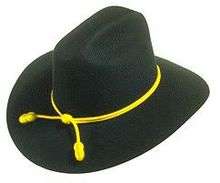
Founded in 1865, John B. Stetson Company began when John B. Stetson headed west and created the original hat of the pioneering American West, the “Boss of the Plains”. This Western hat would become the cornerstone of Stetson's hat business and is still in production today.
Stetson eventually became the world's largest hat maker, producing more than 3,300,000 hats a year in a factory spread over 9 acres (36,000 m2) in Philadelphia. In addition to its Western and fashion hats, Stetson also produces fragrance, apparel, footwear, eyewear, belts, bourbon and a range of other products evoking the historic American West.
Stetson University and Stetson University College of Law in Florida were named after John B. Stetson in 1899 for his contributions to the school.
Beginnings
John B. Stetson was born in 1830 in Orange, New Jersey, where his father Stephen Stetson was a hatter. He worked in his father's shop until he went West for his health.[1]
Prospector's hat
Stetson created a rugged hat for himself made from thick beaver felt while panning for gold in Colorado. According to legend, Stetson invented the hat while on a hunting trip while showing his companions how he could make cloth out of fur without tanning.[2][3] Fur felt hats are lighter, they maintain their shape, and withstand weather and renovation better.[4]
Stetson made an unusually large hat from felt he made from hides collected on the trip, and wore the hat for the remainder of the expedition. Although initially worn as a joke, Stetson soon grew fond of the hat for its ability to protect him from the elements. It had a wide brim, a high crown to keep an insulating pocket of air on the head, and was used to carry water.
As their travels continued, a cowboy is said to have seen J. B. Stetson and his unusual hat, rode up, tried the hat on for himself, and paid Stetson for it with a five dollar gold piece, riding off with the first western Stetson hat on his head.[5]
Boss of the Plains
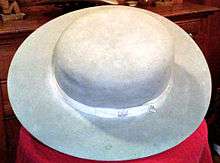
Stetson’s western adventures came to an end in 1865. Stetson, now 35 years old, and in better health, returned east and established his own hat firm in Philadelphia, Pennsylvania, which produced high-quality hats for outdoor use. After producing some initial designs based on popular styles of the day, Stetson decided to create a hat based on his experiences in the American West, which he called the "Boss of the Plains".[6]
The original "Boss", manufactured by Stetson in 1865, was flat-brimmed, had a straight-sided crown, with rounded corners. These lightweight, waterproof hats were natural in color, with four-inch crowns and brims.[7] A plain hatband was fitted to adjust head size.[8] The sweatband bore John B. Stetson's name.
Price and popularity
Stetson produced a very expensive hat. The cowboy riding the range wearing the "'Boss of the Plains' hat showed the world that he was doing well".[9] "Within a decade the name John B. Stetson became synonymous with the word 'hat' in every corner and culture of the West." [10]
The shape of the hat's crown and brim were often modified by the wearer for fashion and to protect against weather by being softened in hot steam, shaped, and allowed to dry and cool. Felt tends to retain the shape in which it dries.[11] The high-crowned, wide-brimmed, soft-felt western hats that followed are intimately associated with the American cowboy image.[12]
Mass production
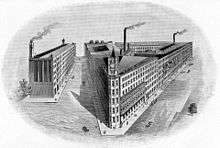
Stetson sent a sample hat to merchants throughout the Southwest with a letter asking for a minimum order of a dozen “Boss of the Plains” hats. The hat was an immediate success: in less than a year Stetson set up a new factory in the outskirts of Philadelphia to handle his growing business. By 1886, Stetson's hat company was the largest in the world, and had mechanized the hat-making industry ("producing close to 2 million hats a year by 1906"). The Stetson Hat Co.ceased production in 1968 and licensed another hat company, but these hats still bear the Stetson name with the hats being produced in St. Joseph, Missouri. Later the license was transferred to another hat company in Texas.[13][2]
"Today's cowboy hat has remained basically unchanged in construction and design since the first one was created in 1865 by J.B. Stetson." [14]
Stetson also produced “dress” hats, distinguished from “western” hats by narrower brims and shorter crowns, but it was his “Boss of the Plains” style hat and its many variants which fueled the company's growth and fame.
Singing cowboys and ten-gallon hats
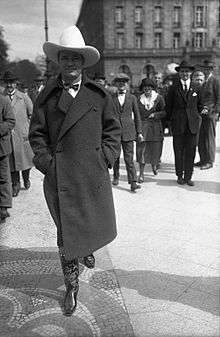
In the 19th century and first half of the 20th century, a hat was an indispensable item in every man's wardrobe. Stetson focused on expensive, high-quality hats that represented both a real investment for the working cowboy and statement of success for the city dweller.
Early on, Stetson hats became associated with legends of the West, including “Buffalo Bill”, Calamity Jane, Will Rogers, and Annie Oakley. It is said that George Custer rode into the Battle of Little Big Horn wearing a Stetson.[15] Later on, Western movie cowboys were quick to adopt the Stetson; many were drawn to the largest, most flamboyant styles available.
Texans were known for their preference for the "Ten Gallon" model. According to Win Blevins' Dictionary of the American West (p388), the term "ten-gallon" has nothing to do with the hat's liquid capacity, but derives from the Spanish word galón (braid), ten indicating the number of braids used as a hat band. However, an early Stetson advertising image, a painting of a cowboy dipping his hat into a stream to provide water for his horse, symbolized the cowboy hat as an essential part of a stockman’s gear and was later featured inside every western style hat.
Changing fashions
Stetson also produced women’s hats, operating a millinery department from the 1930s to 1950s. Hat sales suffered during the Depression years, but Stetsons remained ubiquitous until Americans' embrace of headwear faded after WWII. At its peak Stetson had operations in Australia, Brazil, Colombia, Finland, Guatemala, Ireland, Japan, Mexico, New Zealand, Norway, South Africa and West Germany.[6]
Stetson changed its business strategy in the early 1970s, closing its Philadelphia factory in 1971 and continuing in the hat business through licensing arrangements with a number of manufacturers.
Popular demand for western style hats spiked during the 1980s after the success of Indiana Jones and Urban Cowboy movies. Both Western and Dress hats continue to be important men’s accessories.
Diversification
In the 1980s Stetson began to diversify, releasing the first Stetson cologne in 1981 and Lady Stetson in 1986. Luggage, handbags, umbrellas and scarves also carried the Stetson mark. Today, Stetson is available in the US, Canada, Mexico and throughout Europe and Asia. The brand currently carries western hat, fashion hat, fragrance, eyewear, apparel, footwear, belt and accessories, and bourbon.
Military and police uniforms
United States
The hat was first sold in Central City, Colorado in 1865 in a style called the "Boss of the Plains." In some versions of the famous American folk ballad "Stagger Lee", Billy Lyons is killed by Stack A Lee over a Stetson hat. Troopers of modern-day US Army cavalry regiments will often wear the stetson on ceremonial occasions in place of the ACU patrol cap or beret.
The Homicide and Robbery Bureau of the Dallas Police used the Stetson hat as a badge of office.[16]
In addition, on April Fools' Day, 2011, the U.S. Army released a humorous statement that the official black beret of the Army would be replaced by Stetsons. The statement was supplemented by pictures of soldiers with Stetsons photoshopped over their berets, including an Army dog toting a Stetson.[17]
British paramilitary
The Legion of Frontiersmen created in 1905 in England also wore the Stetson.
South African police
The South African Constabulary organised by Robert Baden-Powell, 1st Baron Baden-Powell in 1901 wore the Stetson.
Canadian military
In the Second Boer War, the flat-brimmed Stetson became the standard issue of the 2nd Canadian Contingent, becoming recognized throughout the British Empire as a symbol of Canada. Twelve hundred Canadian troops were part of the South African Constabulary under the leadership of Robert Baden-Powell, and it was after seeing these troops in action at the Relief of Mafeking that Baden-Powel ordered 10,000 of these hats for the British Troops under his command.[18]
Canadian police
The Royal Canadian Mounted Police (RCMP) Red Serge dress uniform includes a Stetson with a flat brim. The Stetson was first used unofficially by the North-West Mounted Police, in place of the traditional white pith helmet, not practical for the Canadian West. The colour for the RCMP Stetson is sometimes referred to as "Belgian Belly"; it is a reddish buff, pastel-like colour of the underfur of the Belgian hare. It is also a very little-used "second name" for the Stetson. Although called a Stetson, the hat type should be considered as a campaign hat.
The Ontario Provincial Police also wore the Stetson (grey woven fabric) as part of their uniform from 1909 to 1930s and again from 1997 to 2009.
References
- Carlson, Laurie. (1998) Boss of the Plains, the hat that won the West. Pg 5, ISBN 0-7894-2479-7
- ETTA REID, Ingenuity, luck united to make Stetson hat. News & Record (Greensboro, NC). TRIAD CLASSIFIEDSDEASOMESTRIADN; Pg. GRN6. September 9, 2007
- Carlson, Laurie. (1998) Boss of the Plains, the hat that won the West. ISBN 0-7894-2479-7
- Snyder, Jeffrey B. (1997) Stetson Hats and the John B. Stetson Company 1865-1970 pg 40 ISBN 0-7643-0211-6
- Snyder, Jeffrey B. (1997) Stetson Hats and the John B. Stetson Company 1865–1970 pg 49 ISBN 0-7643-0211-6
- Stetson Century, Ralph Richmond 1965
- Snyder, Jeffrey B. (1997) Stetson Hats and the John B. Stetson Company 1865–1970 pg 73, pg 51 1997 ISBN 0-7643-0211-6
- Bender, p. 54
- Snyder, Jeffrey B. (1997) Stetson Hats and the John B. Stetson Company 1865–1970 pg 9 ISBN 0-7643-0211-6
- Bender, pg,12
- "suit time period (web forum posting)". Thefedoralounge.com. Retrieved October 29, 2013.
- Snyder, Jeffrey B. (1997) Stetson Hats and the John B. Stetson Company 1865–1970 1997 pg5 ISBN 0-7643-0211-6
- name="Langenberg"
- Reynolds, William and Rich Rand (1995) The Cowboy Hat book. Pg 8 ISBN 0-87905-656-8
- Snyder, Jeffrey B. (1997) Stetson Hats and the John B. Stetson Company 1865–1970 ISBN 0-7643-0211-6
- Bugliosi, Vincent Reclaiming History
- "Stetson hat to be new Army standard headgear". The United States Army. April 1, 2011. Retrieved October 29, 2013.
- "Canada & The South African War, 1899-1902: The Stetson Hat". Canadian War Museum. October 22, 2009. Retrieved October 29, 2013.
Further reading
- Bender, Texan Bix. (1994) Hats & the cowboys who wear them. ISBN 1-58685-191-8
- Carlson, Laurie. (1998) Boss of the Plains, the hat that won the West. ISBN 0-7894-2479-7
- Reynolds, William and Rich Rand (1995) The Cowboy Hat book. ISBN 0-87905-656-8
- Snyder, Jeffrey B. (1997) Stetson Hats and the John B. Stetson Company 1865–1970. ISBN 0-7643-0211-6
